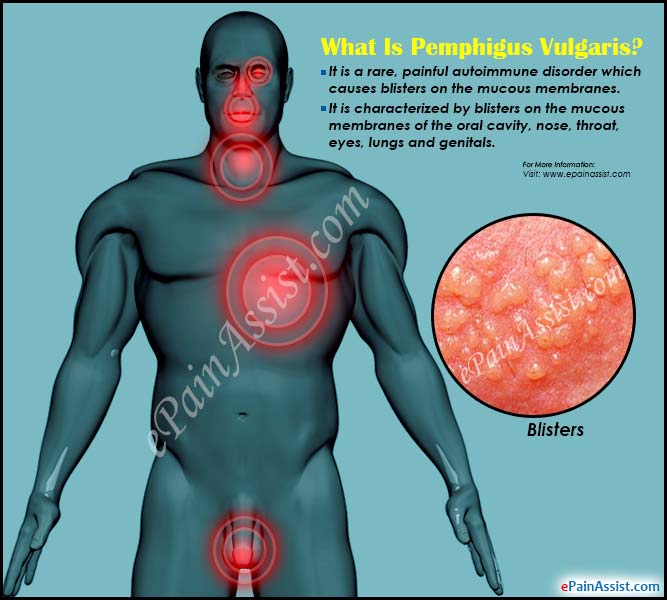What Is Pemphigus Vulgaris?
Pemphigus vulgaris is a rare, painful autoimmune disorder which causes blisters on the mucous membranes. Autoimmune disorder means a patient’s own immune system mistakenly attacks her/his body. Pemphigus vulgaris belongs to a class of autoimmune disorders termed as pemphigus. The type of pemphigus depends on the location of the blisters. Pemphigus vulgaris is characterized by blisters on the mucous membranes of the oral cavity, nose, throat, eyes, lungs and genitals. Pemphigus vulgaris is a serious disease and should be treated promptly. Treatment comprises of corticosteroids for suppressing the immune system. If this condition is left untreated, then it can lead to fatal complications.

Causes of Pemphigus Vulgaris
Pemphigus Vulgaris is an autoimmune disease where the body’s own immune system starts attacking the body mistakenly thinking it as a foreign substance. The body starts to produce antibodies, which instead of attacking foreign bodies like bacteria and viruses start attacking healthy skin and mucous membranes. The exact cause of why this happens is not known. Some medications which rarely are thought to cause pemphigus vulgaris include penicillamine and ACE inhibitors.
Risk Factors for Pemphigus Vulgaris
Pemphigus vulgaris is not a contagious disease. However, there are certain factors which increase the risk, such as genetic factors and family history. Pemphigus vulgaris tends to affect individuals who are of:
- Mediterranean descent
- Individuals living in Brazil’s rain forests.
- Jews from Eastern Europe.
- Middle-aged and older individuals are at increased risk of having this condition.
Types of Pemphigus
Depending of the location of the blisters, the different types of pemphigus include:
- Pemphigus Vulgaris: This is the most common type characterized by initial appearance of painful and non-itchy blisters in the mouth. Blisters then are seen on the skin and on the genitals.
- Pemphigus Foliaceus: In this type of Pemphigus, the blisters initially appear on the face and the scalp. Next, they develop on the chest and back. The blisters are often itchy, but not painful.
- Pemphigus Vegetans: In this type, the blisters develop on the groin, underarms and feet.
- Paraneoplastic Pemphigus: This is a very rare type, which is seen in individuals with some cancers. The sores and blisters develop on the mouth, lips and skin. Patient may also have problem with scarring on the eyes, eyelids and lung problems.
Signs & Symptoms of Pemphigus Vulgaris
- Appearance of painful blisters in the oral cavity.
- The blisters come and resolve on their own and tend to occur on the skin’s surface.
- There is oozing, crusting and peeling at the region of the blisters.
Investigations for Pemphigus Vulgaris
- A physical examination is carried out.
- There is an indicator for this condition known as Nikolsky’s sign, which if positive indicates Pemphigus Vulgaris.
- A biopsy can also be taken from the blister and the sample is sent to the lab for analysis and confirmation of diagnosis
Treatment for Pemphigus Vulgaris
The aim of treatment is to alleviate and manage symptoms by relieving pain and preventing complications, such as infection. Treatment comprises of the following medications:
- Corticosteroids and Immunosuppressants: Corticosteroids given in high dosage is the main line of treatment. These corticosteroids comprise of prednisolone or prednisone.
- Initially high dosage of corticosteroids is required in order to control the symptoms and manage this condition first. However, they should be used with caution, as these drugs have some harmful side effects, such as: Osteoporosis, increased risk for infection, eye problems (cataracts, glaucoma etc.), hyperglycemia, diabetes, decreased muscle mass, water retention and stomach ulcers.
- Patient also needs to take supplements like calcium and vitamin D and follow a low sugar diet.
- The dose of the corticosteroids is reduced after the blisters are under control. The patient is maintained on low dosage to prevent the formation of new blisters and keep the side effects of medicines as less as possible.
- A topical corticosteroid ointment or cream can be applied on the blisters also.
- Immunosuppressants, such as mycophenolate mofetil, azathioprine, methotrexate, rituximab and cyclophosphamide are prescribed along with low dose corticosteroids to control the symptoms.
- Other than these medications, antibiotics, antifungals and antivirals are also prescribed to prevent infections.
- IV Feeding is required for those patients who have severe mouth ulcers and are not able to eat normal food without feeling pain.
- Plasmapheresis is a procedure which eliminates the antibodies from the blood which are mistakenly attacking the skin. This procedure may be done in some patients.
- In case of severe blisters wound management is very important. The treatment given is similar to what is done for severe burns.
- Intravenous electrolytes and fluids are given if there is excess fluid loss through oozing of the blisters.
Other than the above treatments, blister treatment also comprises of:
- Soothing lotions to apply on the skin.
- Lozenges which have a numbing action for mouth blisters.
- Wet dressings also help with pain and discomfort.
- Pain killers can also be given.
- It is important to follow a soft-food diet, especially for blisters in the oral cavity.
- Also it is important to avoid oily, acidic or spicy foods as these may cause irritation of the blisters.
- Avoid overexposing the skin to the sun.
